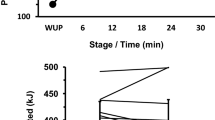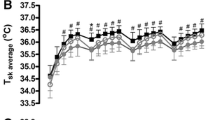Abstract
Environmental limits for uncompensable heat stress, above which an imbalance between heat gain and heat loss forces body core temperature upward (i.e., the upper limits of the prescriptive zone), are unknown for children. To determine these limits, 7 lean and 7 obese 9- to 12-year-old heat-acclimated boys performed four randomized trials each on separate days to determine the critical water vapor pressure (P crit) forcing an upward inflection of body core temperature at several ambient temperatures. Subjects walked continuously on a treadmill at 30% maximal aerobic capacity at a constant dry bulb temperature (T db = 34, 36, 38 or 42°C). After a 30-min equilibration period at 9 torr, ambient water vapor pressure increased approximately 1 torr every 5-min until a distinct breakpoint in the core temperature versus time curve was evident. Compared to the lean subjects, obese subjects had significantly lower environmental limits (P < 0.03) in warm environments (P crit, for lean vs. obese, respectively = 32.9 ± 0.7 vs. 30.3 ± 0.8 torr at T db = 34°C; 29.6 ± 0.6 vs. 27.2 ± 0.9 torr at T db = 36°C; 27.8 ± 0.6 vs. 24.7 ± 0.9 torr at T db = 38°C; 25.5 ± 0.7 vs. 24.5 ± 1.5 torr at T db = 42°C). These results suggest that separate critical environmental guidelines should be tailored to lean and obese children exercising in the heat.


Similar content being viewed by others
References
American Academy of Pediatrics: Committee on Sports Medicine, Fitness (2000) Climatic heat stress and the exercising child and adolescent. American Academy of Pediatrics. Committee on Sports Medicine and Fitness. Pediatrics 106:158–159
Armstrong LE, Maresh CM, Castellani JW, Bergeron MF, Kenefick RW, LaGasse KE, Riebe D (1994) Urinary indices of hydration status. Int J Sport Nutr 4:265–279
Armstrong LE, Epstein Y, Greenleaf JE, Haymes EM, Hubbard RW, Roberts WO, Thompson PD (1996) American College of Sports Medicine position stand. Heat and cold illnesses during distance running. Med Sci Sports Exerc 28:i–x
Bar-Or O (1977) Age-related changes in exercise perception. In: Borg G (ed) Physical work and effort. Pergamon Press, Oxford, pp 255–266
Bar-Or O, Inbar O (1977) Relationship between perceptual and physiological changes during heat acclimatization in 8–10 year old boys. In: Lavallee H, Shephard R (eds) Frontiers of activity and child health: proceedings of the VIIth international symposium of paediatric work physiology. Editions du Pelican, Ottawa, Canada, pp 205–214
Bar-Or O, Ward DS (1989) Rating of perceived exertion in children. In: Bar-Or O (ed) Advances in pediatric sport sciences vol 3 biological issues. Human Kinetics, Champaign, pp 151–168
Bar-Or O, Magnusson LI, Buskirk ER (1968) Distribution of heat-activated sweat glands in obese and lean men and women. Hum Biol 40:235–248
Belding HS, Kamon E (1973) Evaporative coefficients for prediction of safe limits in prolonged exposures to work under hot conditions. Fed Proc 32:1598–1601
Borg G (1970) Perceived exertion as an indicator of somatic stress. Scand J Rehabil Med 2:92–98
Buskirk ER, Bar-Or O, Kollias J (1969) Physiological effects of heat and cold. In: Wilson NL (ed) Obesity. Davis, Philadelphia, pp 119–139
Dougherty KA, Chow M, Kenney WL (2009) Responses of lean and obese boys to repeated summer exercise in the heat bouts. Med Sci Sports Exerc 41:279–289
Drinkwater BL, Kupprat IC, Denton JE, Crist JL, Horvath SM (1977) Response of prepubertal girls and college women to work in the heat. J Appl Physiol 43:1046–1053
DuBois D, DuBois EF (1916) A formula to estimate the approximate surface area if height and weight be known. Arch Intern Med 17:863–871
Eston RG, Lamb KL (2000) Effort perception. In: Armstrong N, van Mechelen W (eds) Paediatric exercise science and medicine. Oxford University Press, Oxford, pp 85–91
Falk B (1998) Effects of thermal stress during rest and exercise in the paediatric population. Sports Med 25:221–240
Goran M, Fields DA, Hunter GR, Herd SL, Weinsier RL (2000) Total body fat does not influence maximal aerobic capacity. Int J Obes Relat Metab Disord 24:841–848
Havenith G, van Middendorp H (1990) The relative influence of physical fitness, acclimatization state, anthropometric measures and gender on individual reactions to heat stress. Eur J Appl Physiol Occup Physiol 61:419–427
Haymes EM, Buskirk ER, Hodgson JL, Lundegren HM, Nicholas WC (1974) Heat tolerance of exercising lean and heavy prepubertal girls. J Appl Physiol 36:566–571
Haymes EM, McCormick RJ, Buskirk ER (1975) Heat tolerance of exercising lean and obese prepubertal boys. J Appl Physiol 39:457–461
Kamon E, Avellini B (1976) Physiologic limits to work in the heat and evaporative coefficient for women. J Appl Physiol 41:71–76
Kamon E, Avellini B, Krajewski J (1978) Physiological and biophysical limits to work in the heat for clothed men and women. J Appl Physiol 44:918–925
Kenney WL, Zeman MJ (2002) Psychrometric limits and critical evaporative coefficients for unacclimated men and women. J Appl Physiol 92:2256–2263
Kenney WL, Lewis DA, Armstrong CG, Hyde DE, Dyksterhouse TS, Fowler SR, Williams DA (1988) Psychrometric limits to prolonged work in protective clothing ensembles. Am Ind Hyg Assoc J 49:390–395
Lind AR (1963) A physiological criterion for setting thermal environmental limits for everyday work. J Appl Physiol 18:51–56
Lohman TG (1987) The use of skinfold to estimate body fatness on children and youth. J Phys Edu Rec Dance 58:98–102
Mahon AD, Marsh ML (1992) Reliability of the rating of perceived exertion at ventilatory threshold in children. Int J Sports Med 13:567–571
Nishi Y, Gagge AP (1970) Direct evaluation of convective heat transfer coefficient by naphthalene sublimation. J Appl Physiol 29:830–838
O’Brien C, Hoyt RW, Buller MJ, Castellani JW, Young AJ (1998) Telemetry pill measurement of core temperature in humans during active heating and cooling. Med Sci Sports Exerc 30:468–472
Owens S, Gutin B (1999) Exercise testing of the child with obesity. Pediatr Cardiol 20:79–83
Parsons KC (2003) Human thermal environments: the effects of hot, moderate, and cold environments on human health, comfort, and performance. Taylor and Francis Group, New York, pp 1–30
Ridgers ND, Stratton G, Fairclough SJ (2005) Assessing physical activity during recess using accelerometry. Prev Med 41:102–107
Robinson S (1942) The effect of body size upon energy exchange in work. Am J Physiol 36:363–368
Rowland TW (2008) Thermoregulation during exercise in the heat in children: old concepts revisited. J Appl Physiol 105:718–724
Saltin B, Hermansen L (1966) Esophageal, rectal, and muscle temperature during exercise. J Appl Physiol 21:1757–1762
Tanner JM (1962) The development of the reproductive system. Growth at adolescence. Blackwell Science, Oxford, pp 28–39
Vroman NB, Buskirk ER, Hodgson JL (1983) Cardiac output and skin blood flow in lean and obese individuals during exercise in the heat. J Appl Physiol 55:69–74
Ward DS, Blimkie CJ, Bar-Or O (1986) Rating of perceived exertion in obese adolescents. Med Sci Sports Exerc 18:S72
Young AJ, Sawka MN, Epstein Y, Decristofano B, Pandolf KB (1987) Cooling different body surfaces during upper and lower body exercise. J Appl Physiol 63:1218–1223
Acknowledgments
We are grateful to the children for their participation in this study and to the parents for supporting them. The technical assistance of Randy McCullough, Doug Johnson, and Jane Pierzga and data collection assistance of Allison Palaio, Matt Kenney, John Jennings, Samantha Wollman, Dave Nhan and Kristin Wielkiewicz is greatly appreciated. We thank the General Clinical Research Center nursing staff for their medical support. This study was supported by National Institute of Health Grants R01-AG-07004-14 (W. L. Kenney), M01-RR-10732 (General Clinical Research Center), the Graduate Student Research Endowment from the College of Health and Human Development, The Pennsylvania State University (K. A. Dougherty), and by the Carl V. Gisolfi Memorial Research Fund from the American College of Sports Medicine Foundation (K. A. Dougherty).
Conflict of interest statement
None of the authors have relevant conflicts of interest to declare.
Author information
Authors and Affiliations
Corresponding author
Additional information
Communicated by George Havenith.
Rights and permissions
About this article
Cite this article
Dougherty, K.A., Chow, M. & Larry Kenney, W. Critical environmental limits for exercising heat-acclimated lean and obese boys. Eur J Appl Physiol 108, 779–789 (2010). https://doi.org/10.1007/s00421-009-1290-4
Accepted:
Published:
Issue Date:
DOI: https://doi.org/10.1007/s00421-009-1290-4




